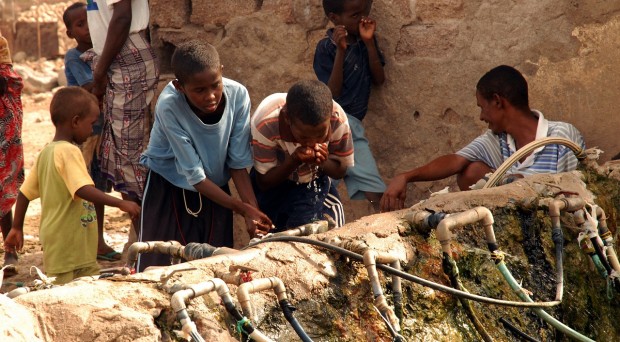
Groundwater is water that lies under the ground in permeable rocks. It is usually found at 100 – 300ft below the surface of the earth. But in some cases it may be even deeper or shallower underground depending on geographic region.
Although, it is naturally a “clean” source of water, this depends on several natural and anthropological factors.
Groundwater is often recharged by rainfall, snow, and sea water. It may be imperilled by its nearness to the coast, thereby recharged by saline water from the sea. Geologic factors like soil and rock types together with the hydrogeology of an area can contaminate this water source.
Water is essential to life and the sustainable development of any human society. Its role cannot be over-stated. Provision of portable water is the seventh item of the millennium development goals, for eradicating poverty and diseases globally.
Water is perhaps the most abundant resource on earth, covering about two thirds of the earth surface. Sadly however, an estimated one billion people in the world, especially in the rural areas of Africa, and many developing regions lack adequate portable water.
Water is a universal solvent. As it dissolves a wide range of substances, it is difficult to find “pure” water naturally. There are national and international guidelines stating values for safe drinking water. The World Health Organization’s water quality standards, stand out as an international bench mark worldwide. These guideline values cover a broad spectrum of physical, chemical and microbiological parameters associated with water.
Temperature, pH, conductivity, total dissolved solids (TDS), turbidity, are some of the physical water quality parameters often determined in any water/groundwater sample. Besides these, odour and colour give clear indication of pollution. However, their absence does not imply clean water.
Chemical contaminants (Ba2+, Ca2+, Na+, Pb2+, Fe2+, Mg2+, Al3+, As3+, CN–, Cd2+, Cd6+, Hg2+, N03-, PO43-, SO42-, Cl–, F–, organics, amongst others) some of which are carcinogenic, maybe found in groundwater from agricultural industry (including fertilizer and pesticides), industrial wastes from sundry industries and mining.
Government and health agencies are obligated to carry out periodic evaluation of groundwater to predict the possibility of bioaccumulation of toxic chemicals.
Arising from mineral dissolution and ion-exchange occasioned by pH differentials along flow paths through rock and soil types; and leachates from faulty septic tanks, landfills, underground storage tanks, oil spills, used motor oil, automobile and metal dumpsites.
Microbiological pathogenic organisms can contaminate groundwater from sewage leachates, especially in aquifers with a low lying water table. These can be hazardous on human and animal health.
According to an update by WHO and UNICEF, 1.8 billion people use a source of drinking water that is faecally contaminated. And annually 1.8 million human deaths are attributed to waterborne diarrheal diseases according to the World Health Organization.
Up to 88% of this is attributable to unsafe water supply, sanitation and hygiene. Acute side effects of diarrhoea, headache, nausea and vomiting as well as chronic cases of cancer, anaemia, kidney and liver damage, nervous, circulatory, and reproductive problems are associated with consumption of contaminated groundwater. Governments in many of these countries struggle to provide water for the teeming population especially in remote areas.
Groundwater supply has contributed enormously to the eradication of hitherto prevalent diseases like river blindness, guinea worm, cholera, and typhoid fever in numerous communities around the world.
Many no longer rely on streams, stagnant lakes, and contaminated wells for their water supply. Thereby saving lives, hospital bills, and huge man-hour. 60 per cent of the population in In Sub-Saharan African and 50 per cent of the population in Oceania now use improved sources of drinking-water.
In our studies on the groundwater quality of Agbor and Owa communities of Delta State, Nigeria, we found that the groundwater was largely wholesome and generally safe. Furthermore, it also revealed slight variations in groundwater quality as you moved from township to the suburbs/rural areas; the latter being relatively better in quality.
Presently, many households now have borehole water source within the precinct of their homes. However, government and health agencies are obligated to carry out periodic evaluation of groundwater to predict the possibility of bioaccumulation of toxic chemicals and diseases of possible epidemic proportion.
4 Comments